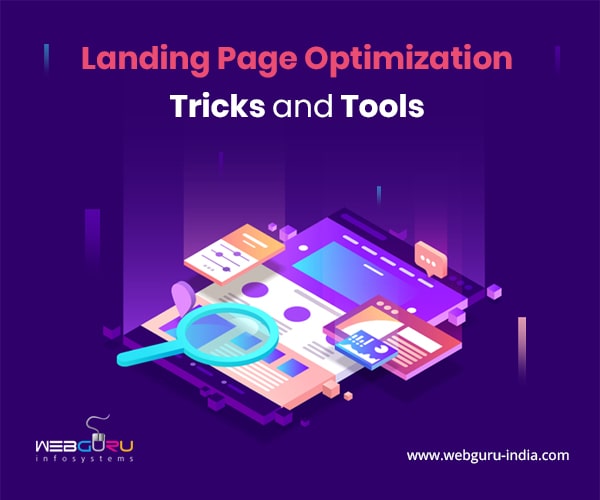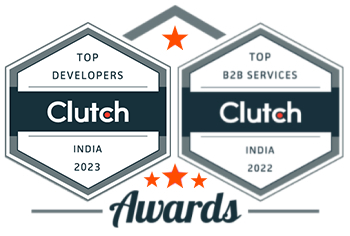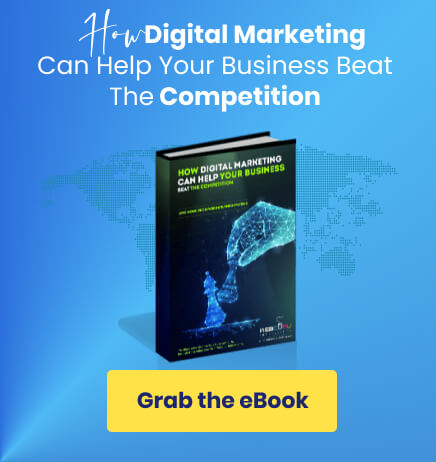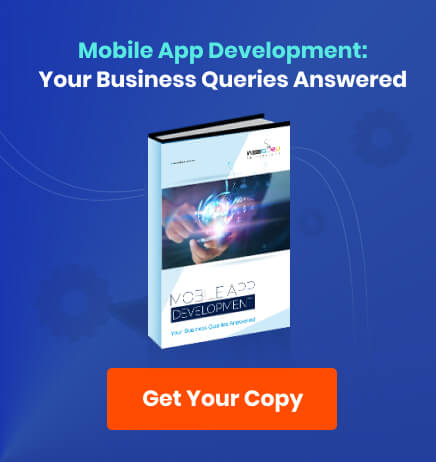Home Blog Website Design Services Landing Page Optimization – Tricks and Tools
Landing Page Optimization – Tricks and Tools
- 25 Apr / 2023
- 2,120 views
- 6 Min Read

Knowing how to drive people to your website is only half the battle for a marketer. You need to turn them into customers once they arrive. And that’s where landing pages come in. A landing page is a standalone web page that’s designed to persuade visitors to take a specific action. This can include filling in a lead form or purchasing a product.
So how are landing pages different from websites? Simple: You might consider a website to be a collection of web pages, including landing pages. A landing page has a very specific goal of encouraging conversions. Whereas, a website provides information on topics people look for. Hence, on clicking the CTA button of a landing page, the user is directed to another page of the same website.
But creating a landing page doesn’t automatically guarantee conversions. To optimize your landing page, you must know the things that work. In this post, we’ll explore the best practices followed by the top website design service providers to create landing pages that convert.
Why Landing Page Optimization Matters
First, let’s talk about why landing page optimization is so important. According to HubSpot, companies with more than 30-40 landing pages generate 7 times more leads than those with 1-5 landing pages. That’s a huge difference. But it’s not just about quantity. It’s also about quality. Your conversion rate may increase as a result of properly optimized landing pages, which will result in more leads, sales, and income. And who doesn’t want that?
Best Practices
So, what makes a landing page effective? Let’s dive into the best practices.
1. Keep It Simple
The first best practice is to keep your landing page simple. Don’t overwhelm your visitors with too much information or too many options. Rather, concentrate on the one action you want them to take. Use enough white space and brief, clear language to make the page easy to read. Recall that little is more.
For example, check out this landing page copy from Slack:
- Headline: Slack is where work flows.
- Copy: When your team needs to kick off a project, hire a new employee, deploy some code, review a sales contract, finalize next year’s budget, measure an A/B test, plan your next office opening, and more, Slack has you covered.
- Call-to-action: Get started for free.
Notice how the page is focused on one thing – getting you to sign up for Slack. The headline is clear and concise, and the copy explains the benefits of using Slack. The call-to-action is easy to find and easy to understand. That’s what a good landing page looks like.
2. Crafting Strong Headlines and Copy
Visitors will see your headline first, so it ought to pique their interest and compel them to continue reading. A strong headline emphasizes the advantages of your product or service in a clear, succinct manner. It should also be relevant to the ad or email that brought the visitor to your landing page in the first place.
Here are a few examples of strong headlines:
- For a fitness app: Get Fit in 30 Days with Our Personalized Workout Plan.
- For a CRM company: Say Goodbye to Spreadsheet Chaos with Our Project Management Tool.
- For an online marketing course: Double Your Sales with Our Proven Marketing Strategies.
Once you’ve got their attention with your headline, it’s time to convince them to take action with your copy. Your copy should be clear, concise, and benefit-driven. Focus on the benefits of your product or service, not the features. Use simple language and avoid jargon. And don’t forget to include social proof, which we’ll talk about later.
3. Create a Clear Call-to-Action
The button or link that visitors click to complete the intended activity is known as your call-to-action (CTA). The CTA button must be obvious, large, and above the fold (i.e., accessible without scrolling). Use action-oriented language, such as “Get started” or “Sign up now”. And make sure your CTA stands out by using a contrasting color or a larger font size.
Here are some examples of effective CTAs:
- For a newsletter sign-up:“Subscribe now”
- For a free trial:“Start my free trial”
- For an eCommerce site:“Buy Now – only on sale till midnight!”
4. Use High-Quality Images and Videos
A landing page is a place where a picture really does speak a thousand words. Use top-notch photos and videos to promote your goods or services. Verify that the images relate to the copy and the page’s overall message. And don’t forget to optimize your images for fast loading times.
For instance,
- For a travel website, use a stunning photo of a beach or a city skyline to persuade people to make travel arrangements.
- For a meal delivery service, use enticing pictures of your cuisine to attract people to your food.
- Use a video to explain how your product functions and how it can help the user if you are a SaaS company.
5. Make It Mobile-Friendly
More and more people are browsing the web on their mobile devices, so it’s crucial that your landing page is optimized for mobile. Make sure your page is responsive, meaning it adjusts to fit the size of the screen. Use larger font sizes and clear, easy-to-click buttons. And don’t forget to test your landing page on different screen resolutions to ensure it looks great across the board.
With the advent of a new generation of foldable devices, the work for web designers now also has an additional step. You must make sure your landing pages are optimized for foldable screens as well. This will ensure a positive experience for future viewers as well, as more and more people adopt these devices.
6. Optimize Your Forms
If your landing page includes a form, make sure it’s optimized for conversions. Keep the form short and sweet, only asking for the information you really need. Use clear, concise labels and instructions.
7. Use Social Proof
“Join over 10,000 satisfied customers” – a text like this can increase trust and credibility, significantly improving your odds of creating a conversion. The concept of “social proof” holds that people are more inclined to do something if they observe others doing it. You can incorporate a variety of social proof on your landing page, including:
- Testimonials: Use quotes from satisfied customers to increase credibility.
- Reviews: Include ratings and reviews from third-party sites like Yelp or Google.
- Trust badges: Display logos of trusted brands or security badges to increase trust.
- Statistics: Use numbers to demonstrate the popularity or effectiveness of your product or service.
8. Test Your Landing Page
The most important tip is to test your landing page. Landing pages differ from one another. In other words, what might work for one business might not work for another. It is therefore important to check or test various aspects/elements of your landing page and find out the ones that click with your audience. Try different headlines, different images, and different CTAs. Use A/B testing tools (which we’ll talk about in the tools section) to determine what works best for your specific audience.
Tools for Testing Landing Pages
Here are some tools that can help you create the best landing pages that are perfectly optimized for conversions.
A. A/B Testing Tools
You can test many iterations of your landing page using A/B testing tools to see which one performs the best. Several well-liked A/B testing software tools are:
- Google Optimize: Is a free, user-friendly tool.
- Optimizely: A more advanced tool with a free trial.
- Unbounce: A landing page builder that includes A/B testing.
B. Heatmapping Tools
You can see where visitors are clicking and scrolling on your landing page by using heatmapping tools. You can use this to pinpoint areas that want improvement. Some popular heatmapping tools include:
- Crazy Egg: A comprehensive heatmapping tool with a free trial.
- Hotjar: A more affordable option with a free plan.
- Mouseflow: A tool that includes heatmaps as well as session replays and form analytics.
C. Conversion Rate Optimization Tools
Conversion rate optimization (CRO) tools are designed to help you increase your conversion rate. Some popular CRO tools include:
- Leadpages: A landing page builder with built-in conversion optimization features.
- VWO: A comprehensive CRO tool with A/B testing, heatmaps, and more.
- Convert: A tool with behavioral targeting, personalisation, and A/B testing.
A well-designed and optimized landing page can go a long way in making your website successful. However, there are other options as well. For advice on how to make your website successful which will guarantee steady business growth, read our blog.
Conclusion
Making a landing page is only the beginning. To enhance the same, you need to know the stuff that works. Ensure you make your landing page while keeping the visitor in mind. By following the accepted procedures and practices we’ve outlined and utilizing the tools we’ve talked about, you can make landing pages that convert.
Landing page creation is a tricky and time-consuming process. However, our team of experienced web specialists can help you build immaculate landing pages. Call us today and set the ball rolling.

Shrutarshi Das
Shrutarshi Das is a purveyor of all things digital, with a particular interest in new technological innovations, photography, and gaming.
1 comment
Leave a Reply

-
1000+
Happy
Clients -
25+
Countries
Served -
19+
Years of
Trust








Very excellent blog writing. Thank you for sharing the information in the blog.